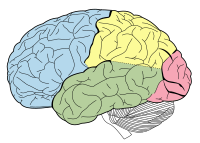
Photo from wikipedia
OBJECTIVE Evaluate physiological and perceptual responses using a phase change cooling (PCC) garment during simulated work in the heat. METHODS Twenty males wearing compression undergarments, coverall suit, gloves, and hard-hat,… Click to show full abstract
OBJECTIVE Evaluate physiological and perceptual responses using a phase change cooling (PCC) garment during simulated work in the heat. METHODS Twenty males wearing compression undergarments, coverall suit, gloves, and hard-hat, completed two randomly assigned trials (with PCC inserts or control, CON) of simulated industrial tasks in the heat (34.2 ± 0.05 °C, 54.7 ± 0.3%RH). Trials consisted of two 20 min work bouts, a maximum performance bout, and 10 min of recovery. RESULTS Physiological strain index (PSI) was lower during PCC after the second work bout and during recovery (all P < 0.05). PCC reduced heat storage (27.0 ± 7.6 W m-2) compared to CON (42.7 ± 9.9 W m-2, P < 0.001). Perceptual strain index (PeSI) was reduced with PCC compared to CON (P < 0.001), however performance outcomes were not different between trials (P = 0.10). CONCLUSIONS PCC during work in the heat attenuated thermal, physiological, and perceptual strain. This PCC garment could increase safety and reduce occupational heat illness risk.
Journal Title: Applied ergonomics
Year Published: 2017
Link to full text (if available)
Share on Social Media: Sign Up to like & get
recommendations!